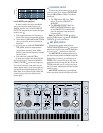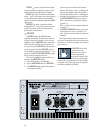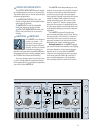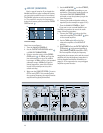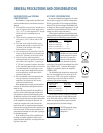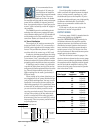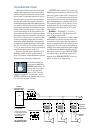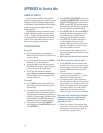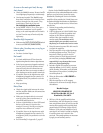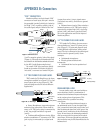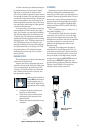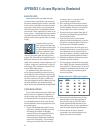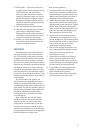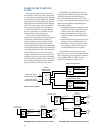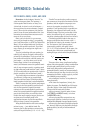32
APPENDIX A: Service Info
• If the
OUTPUT APPLICATION
switch is set
to
LOW OUT (SUBWOOFER)
, make sure the
LOW CUT FILTER
frequency control is set
to
OFF
or nearly
OFF
. If it is turned up above
the subwoofer cutoff frequency, the output
from the amplifier will be diminished.
• Is the
SHORT
LED lit? Turn the
POWER
off,
check the speaker connections and make
sure that there are no strands of wire
shorting across the speaker terminals.
• Is the
HOT
LED lit? Make sure there is
cool air available at the front of the
amplifier. Make sure there is room at the
sides of the amplifier for warm air to exit.
Allow the amplifier to cool off.
• Are there fuses in the speaker or in-line
fuses in the speaker wire? Check ’em to see
if they’re blown.
• Make sure the speakers are working properly.
One side is way louder than the other!
• Do the M•2600’s meters read the same
on both sides? If not, your source may be
delivering an out-of-balance stereo signal.
• Are both
GAIN
knobs set to the same
position?
• Are the speaker(s) impedances
matched? (See Appendix D— “ do The
Math: Ohms, Loads, and Such.”)
• Try swapping sides: Turn off the amp,
swap the speaker cables at the amp, turn
the amp back on. If the same side is still
louder, the problem is with your speakers
or speaker cabling. If the other side is
louder now, the problem is with the
mixer, the amp, or the line-level cabling.
The stereo music sounds kind of sideways,
and the bass frequencies diminish when
standing center, but get louder as you
approach one side!
• Check the polarity of the speaker cable
connections. You may have your positive
and negative connections reversed at
one end of one speaker cable.
WARRANTY SERVICE
If you think your amplifier has a problem,
please do everything you can to confirm it before
calling for service, including reading through
the following Troubleshooting section. Doing so
might save you from being deprived of your
Mackie amplifier.
Of all Mackie products returned for service
(which is hardly any at all), many are coded
“CND” — Could Not Duplicate, which usually
means the problem lay somewhere else in the
system. These may sound obvious to you, but
here are some things you can check:
TROUBLESHOOTING
No power!
• Our favorite question: Is it plugged in?
Make sure the AC outlet is live (check with
a tester or lamp).
• Our next favorite question: Is the
POWER
switch on? If not, try turning it on.
• Is the green light next to the power switch
illuminated? If not, make sure the AC outlet
is live. If so, refer to “No sound” below.
• The AC line fuse inside the chassis is
blown. This is not a user-serviceable part.
Refer to “Repair” on the next page to find
out how to proceed.
No sound!
• Are the
GAIN
controls turned all the way
down? Slowly turn them up and see if you
hear anything.
• Is the signal source turned up? Make sure
the signal level from the mixing console (or
whatever device immediately precedes the
amplifier) is high enough to produce sound
in the amplifier. The
SIG
LEDs should be
blinking to indicate that signal is present.
• If the speakers are wired for
BRIDGED
mode, make sure the
AMP MODE
switch is
set to
BRIDGED
.




